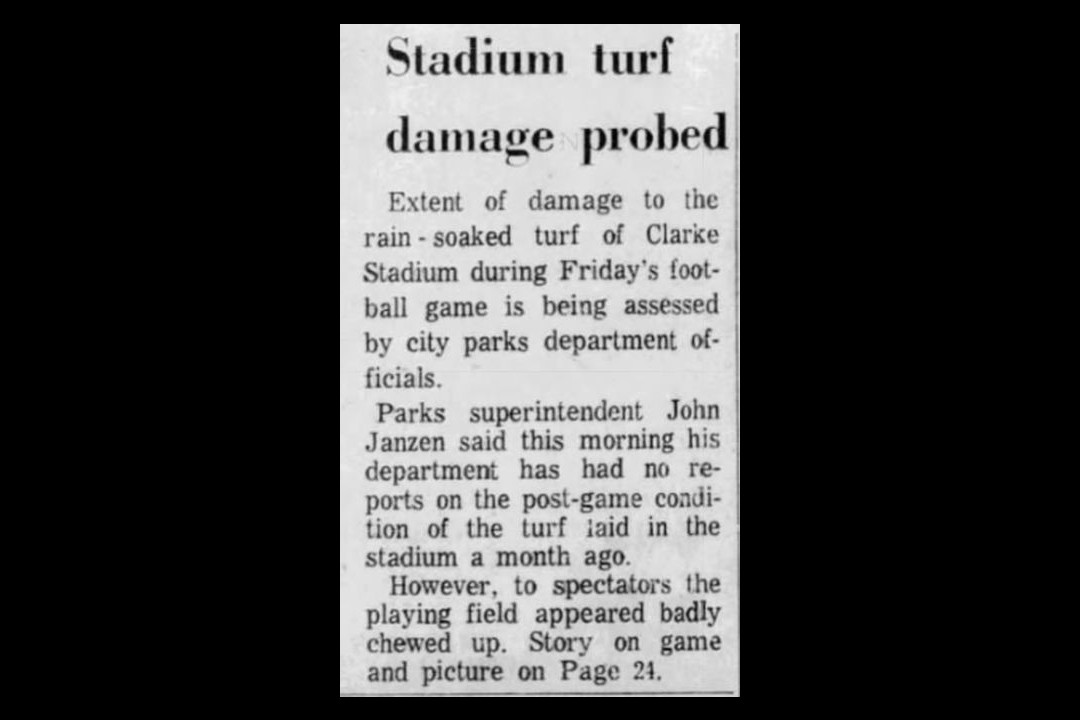On this day in 1971, the City of Edmonton was investigating the torn-up turf at Clarke Stadium.
The turf in question was about a month old, according to the then-head of the city's park department. A combination of rainy weather and a Friday football game had led to the chewed-up field.
Clarke Stadium has hosted football games in Edmonton for nearly a century. Edmonton Mayor Joseph Clarke championed the field during his second term in the mid-1930s. Clarke was a friend of then-Prime Minister William Lyon Mackenzie King, and was able to get the federal government to lease the city a section of land in east Edmonton for a new football stadium. In addition to being mayor, Clarke was an accomplished athlete who played both football and lacrosse, which partially led to his nickname of Fightin' Joe (though the fact that he once got in a wild punch-up during a city council meeting might have also been a factor.)
Once built, Clarke Stadium became the home field for the Edmonton Elks, under the team's former name. The team was part of the newly-formed Western Interprovincial Football Union, where they played against the Winnipeg Blue Bombers, the Calgary Bronks, and the Regina Roughriders. But that arrangement didn't last long: Edmonton only played two seasons before pulling out of the league due to the Second World War.
Edmonton rejoined the union in 1949 and remained when it became part of the Canadian Football League. The team continued to play out of Clarke Stadium for the next three decades. When Edmonton was selected to host the 1978 Commonwealth Games, the stadium was originally set to be one of the facilities to host events. However, it quickly became apparent that Clarke wasn't going to fit the expected crowds. So, construction began on Commonwealth Stadium directly beside Clarke. After the Commonwealth Games, Edmonton's football team moved next door to the brand-new facility, although it continued to use Clarke as a practice field.
Football wasn't the only game in town. The Edmonton Drillers soccer team originally played out of Commonwealth after the team was formed in 1979. But after a couple of seasons, they moved into the smaller Clarke Stadium until the team folded in 1982. The 1980s saw two other short-lived soccer teams play at Clarke — the Edmonton Eagles and the Edmonton Brick Men.
By the turn of the century, Clarke was showing its age. In 2000, a major renovation updated seating and modernized many of the facilities.
FC Edmonton started playing out of Clarke during their second season in 2012. The team's ownership pushed for another major renovation of the stadium in 2018, arguing that the current facility was inadequate and outdated as the team was preparing to join the Canadian Premier League. The request started a bit of a turf war with the professional and high school football teams that used Clarke. In the end, while some changes were made, the plan for a major rehaul of Clarke was abandoned. FC Edmonton suspended its 2023 season due to low attendance numbers and hasn't returned to the stadium.
While it's shadowed by its much larger neighbour, Clarke Stadium is still a hub for outdoor sports in Edmonton. It still serves as the practice grounds for the Edmonton Elks and is used by junior football teams and for high school matches, as well as by MacEwan University. Two weeks ago, Clarke Stadium and Commonwealth Stadium hosted teams from all over the world for the IFAF World Junior Football Championships, which saw Canada hold on to its top spot for a third year with a final win over Japan.
This clipping was found on Vintage Edmonton, a daily look at Edmonton's history from armchair archivist @revRecluse of @VintageEdmonton.

